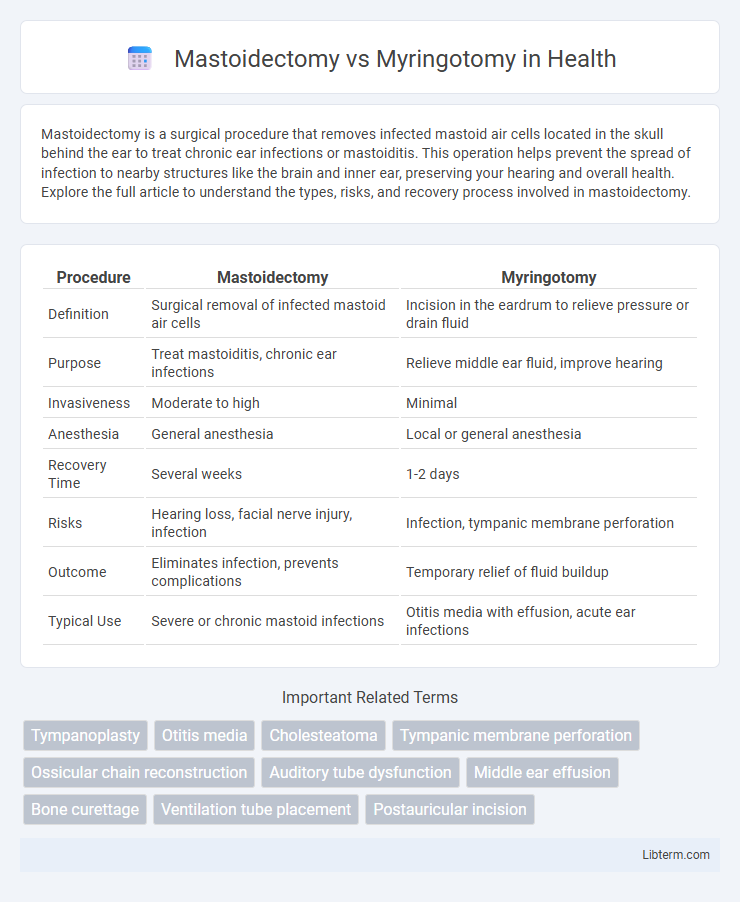Mastoidectomy is a surgical procedure that removes infected mastoid air cells located in the skull behind the ear to treat chronic ear infections or mastoiditis. This operation helps prevent the spread of infection to nearby structures like the brain and inner ear, preserving your hearing and overall health. Explore the full article to understand the types, risks, and recovery process involved in mastoidectomy.
Table of Comparison
| Procedure | Mastoidectomy | Myringotomy |
|---|---|---|
| Definition | Surgical removal of infected mastoid air cells | Incision in the eardrum to relieve pressure or drain fluid |
| Purpose | Treat mastoiditis, chronic ear infections | Relieve middle ear fluid, improve hearing |
| Invasiveness | Moderate to high | Minimal |
| Anesthesia | General anesthesia | Local or general anesthesia |
| Recovery Time | Several weeks | 1-2 days |
| Risks | Hearing loss, facial nerve injury, infection | Infection, tympanic membrane perforation |
| Outcome | Eliminates infection, prevents complications | Temporary relief of fluid buildup |
| Typical Use | Severe or chronic mastoid infections | Otitis media with effusion, acute ear infections |
Introduction to Mastoidectomy and Myringotomy
Mastoidectomy involves the surgical removal of infected mastoid air cells located in the temporal bone to treat chronic ear infections and prevent the spread of infection to surrounding structures. Myringotomy is a minimally invasive procedure that creates a small incision in the eardrum to drain fluid and relieve pressure, commonly performed to treat middle ear infections and effusions. Both procedures address ear infections but differ in invasiveness, target anatomy, and specific clinical indications.
Anatomy and Indications for Surgery
Mastoidectomy involves the surgical removal of infected mastoid air cells located within the temporal bone behind the ear, primarily indicated for chronic mastoiditis or cholesteatoma to prevent the spread of infection. Myringotomy entails making a small incision in the tympanic membrane (eardrum) to relieve middle ear pressure and drain fluid, commonly performed to treat recurrent otitis media with effusion or acute otitis media. Both procedures target different anatomical structures and are chosen based on the severity and chronicity of middle ear and mastoid infections.
What is Mastoidectomy?
Mastoidectomy is a surgical procedure aimed at removing infected mastoid air cells within the mastoid bone, located behind the ear, often to treat mastoiditis or chronic ear infections. It involves accessing the mastoid bone to eliminate infection and prevent complications such as hearing loss or intracranial infections. This differs from myringotomy, which involves creating a small incision in the eardrum to drain fluid and relieve pressure in the middle ear.
What is Myringotomy?
Myringotomy is a surgical procedure involving a small incision in the tympanic membrane to relieve pressure caused by excessive fluid buildup or infection in the middle ear. It is often performed to treat otitis media with effusion or chronic ear infections, providing immediate drainage and pain relief. Compared to mastoidectomy, which involves the removal of infected mastoid air cells, myringotomy is less invasive and primarily focuses on middle ear ventilation and fluid drainage.
Key Differences Between Mastoidectomy and Myringotomy
Mastoidectomy involves surgical removal of infected mastoid air cells in the temporal bone, primarily addressing mastoiditis or chronic ear infections with complications. Myringotomy is a minimally invasive procedure creating a small incision in the tympanic membrane to drain middle ear fluid and relieve pressure, often followed by tube insertion to prevent fluid accumulation. The key difference lies in the extent and purpose: mastoidectomy treats extensive infection and bone involvement, while myringotomy focuses on fluid drainage and pressure relief in the middle ear.
Indications for Choosing Mastoidectomy
Mastoidectomy is indicated primarily for chronic mastoiditis, cholesteatoma, or persistent middle ear infections that do not respond to antibiotics or myringotomy. It is preferred when there is extensive bone erosion, intracranial complications, or mastoid air cell system involvement requiring surgical removal. Myringotomy is typically reserved for less severe cases involving middle ear effusion or acute otitis media needing ventilation tube placement.
Indications for Choosing Myringotomy
Myringotomy is primarily indicated for patients with recurrent otitis media or persistent middle ear effusion causing hearing loss or pain, especially when less invasive intervention is preferred. This procedure is often chosen for quick relief and to ventilate the middle ear by inserting tympanostomy tubes, reducing the frequency of infections and preventing long-term complications in pediatric cases. In contrast, mastoidectomy is reserved for more severe infections involving mastoid air cells or cholesteatoma, where myringotomy alone is insufficient.
Risks and Complications: Mastoidectomy vs Myringotomy
Mastoidectomy carries higher risks and complications compared to myringotomy due to its invasive nature, including potential facial nerve injury, hearing loss, and intracranial infections. Myringotomy, being less invasive, primarily risks minor bleeding, infection, and tympanic membrane perforation. Careful patient evaluation and surgical expertise are critical in minimizing adverse outcomes in both procedures.
Recovery and Postoperative Care Comparison
Mastoidectomy recovery typically requires several weeks with close monitoring for infection, pain management, and limited physical activity, while myringotomy offers a faster recovery, often within days, due to its minimally invasive nature. Postoperative care for mastoidectomy involves wound care, antibiotics, and regular follow-up to assess hearing and prevent complications, whereas myringotomy aftercare focuses on keeping the ear dry, monitoring for tube displacement, and managing minor drainage. Both procedures necessitate avoiding water exposure and maintaining ear hygiene, but mastoidectomy patients face a more intensive recovery process due to the procedure's complexity.
Choosing the Right Procedure: Factors to Consider
Choosing between mastoidectomy and myringotomy depends primarily on the severity and location of ear infections or complications. Mastoidectomy is typically recommended for chronic mastoiditis or when infections have spread to the mastoid bone, while myringotomy is preferred for relieving middle ear pressure or drainage in less severe cases, especially in children. Factors such as the presence of cholesteatoma, frequency of ear infections, hearing loss, and patient age are critical in determining the most appropriate surgical approach.
Mastoidectomy Infographic

 libterm.com
libterm.com